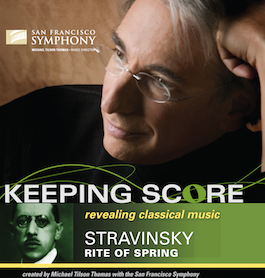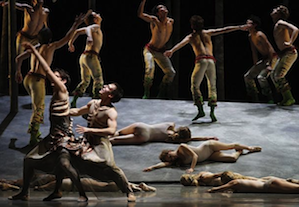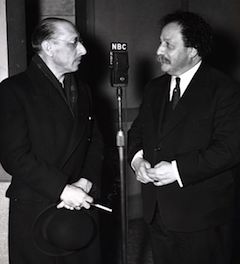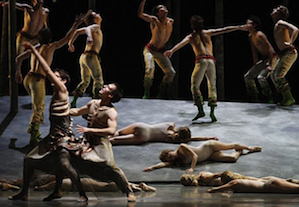
"The brilliant use of the winds. The percussion. The snarling trombones. The glissandos. In other words, Stravinsky really began his musical revolution by using his teacher's music. That Russian, fairytale music that his teacher had perfected."
That's one of Michael Tilson Thomas' many fascinating insights in his Keeping Score introduction to the San Francisco Symphony recording of Stravinsky's The Rite of Spring: Rimsky-Korsakov's influence on Stravinsky. Rather than Stravinsky springing forth, fully formed, as the great, shocking innovator, he was part and parcel of a band of 19th-century Russian composers "inspired by the old myths and epics and fairytales, and they all used folksongs and chants to give their music a very particular Russian flavor."
Still, as MTT and SFS now celebrate the centennial of the Rite with four concerts, the conductor is quite willing to credit Stravinsky with "that edgy out-of-control feeling that makes it as exhilarating and liberating as music can be."
The SFS series begins at 10 a.m. on June 19, with an open rehearsal, then continues the same evening at 8, and the next day at 2 p.m. with performances of Rite, plus featuring Gil Shaham as soloist in the Stravinsky Violin Concerto, and another work forever associated with George Balanchine's choreography, Agon. These concerts will be broadcast at 8 p.m. July 2 on KDFC-FM and kdfc.com.

Photo by Erik Tomasson
On June 21 and 22, the Davies Symphony Hall concerts will feature the Dmitri Pokrovsky Ensemble in traditional Russian folk songs, and Stravinsky's Les Noces, in addition to Rite.
Definitely not as "shocking" as it was 100 years ago, Rite is utterly thrilling. Keeping Score describes the work's finale:
The music becomes louder, more compacted, it seems faster. And then it goes totally over the edge. It's just a moment of quivering silence. And then, the instant that Stravinksy imagined from the beginning. The moment when the sacrificial maiden's neck would snap and the whole community would lift her up to the sky in triumph.What kind of music could represent such a violent moment? Stravinsky contrived a wild noise consisting of shrieking piccolos and strings on the upbeat, with a touch of the South American scraper, the guiro [imitates guiro], and then on the downbeat, an immense crash by brass strings and percussion.
And a surprising footnote from MTT: "By a strange accident of fate, the notes in the bass part on the very last note of the piece are, reading from the bottom, D, E, A, D, Dead. Course, Stravinsky would not have known that; it was just an accident."

When the San Francisco Ballet produced Yuri Possokhov's Rite in 2012 and this year, I asked double bassist Shinji Eshima what it was like to play that music five times in three days. His response: "100 years later, it is still wondrous. It is the most original. It is what every composer aspires toward even now. It is thrilling to play and also terrifying. It is a marvel to play, surrounded by colors and the sheer joy of pure rhythm. One feels like you are dancing inside while playing and yes afterward, it is exhausting (like you need a cigarette)."
Here are just a few from the dozens of recent pre-centennial Rite performances:
MTT/SFS, Simon Rattle conducting the Berlin Philharmonic, choreography by Royston Maldoom; a strange doubleheader, with both the four-hand and full orchestral versions in one video, Uwe Scholz's choreography, Henrik Schaefer conducting Gewandhausorchester Leipzig; Joffrey Ballet, Allen Lewis conducting the Orchestra of the National Theater Prague.
The riotous May 29, 1913, premiere of Rite in Paris' Théâtre des Champs-Élysées was a musical landmark, and it also intertwined with the history of the then 2-year-old SFS: Pierre Monteux conducted Sergei Diaghilev Ballets Russes Rite premiere (and the first Petrushka, Daphnis et Chloé, and Jeux, among others), and then, from 1935 to 1952 Monteux presided over the San Francisco Symphony, where "his choice of modern works drew occasional complaints from conservative-minded members of the audience."
Monteux was not always so adventurous. Few remember today how Monteux had been appalled when Stravinsky first played the Rite score at the piano:
I decided then and there that the symphonies of Beethoven and Brahms were the only music for me, not the music of this crazy Russian ... My one desire was to flee that room and find a quiet corner in which to rest my aching head. Then [Diaghilev] turned to me and with a smile said, "This is a masterpiece, Monteux, which will completely revolutionize music and make you famous, because you are going to conduct it."
Also, as a very young musician in LA, MTT met Stravinsky, visited his home and attended some rehearsals: "I was just very lucky, hearing him conduct and even sing his music." As a boy, MTT owned a 78 RPM recording of Rite, and he wore down the grooves until the discs became unplayable. He now has the brand-new Blu-ray edition of his own performance, and chances are this disc will last longer.

